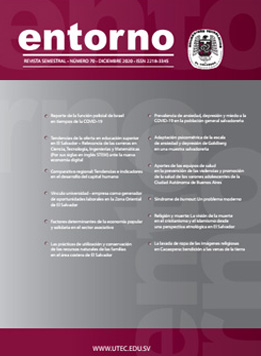Prevalence of anxiety, depression and fear of COVID-19 in the general Salvadorean population
Published 2020-12-15
Keywords
- Anxiety,
- Depression,
- Fear - psychological aspects,
- Fear of death,
- Covid-19 - Psychological aspects
Copyright (c) 2020 Edgardo René Chacón-Andrade; Marlon Elías Lobos-Rivera; Mauricio Cervigni; Miguel Gallegos; Pablo Martino; Tomás Caycho-Rodríguez; Ignacio Barés; Manuel Calandra; Angélica Nohemy Flores-Monterrosa

This work is licensed under a Creative Commons Attribution-NonCommercial-ShareAlike 4.0 International License.
How to Cite
Abstract
The main objective of this article is to determine the prevalence of anxiety, depression and fear symptoms at the face of COVID-19 in the Salvadorean population. In like manner, to determine the seriousness in each psychological variable as well as to find out whether there is a connection with the socio-demographic characteristics of the sample. This is an exploratory study with a transversal design; in order to collect the data, an online survey was conducted via Google Forms. A non-probabilistic sample of 328 Salvadoreans was taken. The mean for the age is 27.90 years old, with a SD of 9.10; in regards to gender, the mean is of 29.05 for men, with a SD of 9.94, and for women, a mean of 27.42, with a SD of 8.70. The findings show a high prevalence of anxiety symptoms; these fluctuate between 60 % and 80 %. Those symptoms related to depression are between 50 % and 70%, and finally, in relation to fear to COVID-19, there was a prevalence between 20 % and 40 %. In terms of the degree in which it affected people, 90 % of the sample shows moderate to severe anxiety and depression levels. It was possible to establish connections among gender, age, and the amount of hours spent thinking about COVID-19. In regards to fear of COVID-19, the findings show that about 30 % of the sample has been affected by it in relation to gender and the number of hours spent thinking about COVID-19.
Keywords: Anxiety, Depression, Fear - psychological aspects, Fear of death, Covid-19 - Psychological aspects.
DOI: https://doi.org/10.5377/entorno.v0i70.10373
URI: http://hdl.handle.net/11298/1183
References
- Cohen, J. (1988). Statistical power analysis for the behavioral sciences (2nd ed.). New York, United States: Lawrence Erlbaum Associates.
- Dosil Santamaría, M. D., Ozamiz-Etxebarria, N., Redondo Rodríguez, I., Alboniga-Mayor, J. J. y Picaza Gorrotxategi, M. (junio, 2020). Impacto psicológico de la COVID-19 en una muestra de profesionales sanitarios españoles. Revista de Psiquiatría y Salud Mental. doi: doi.org/10.1016/j.rpsm.2020.05.004
- Elbay, R. Y., Kurtulmus, A., Arpacioglu, S. & Karadere, E. (agosto, 2020). Depression, anxiety, stress levels of physicians and associated factors in Covid-19 pandemics. Psychiatry Research, 290, 113-130. Recuperado de https://www. ncbi.nlm.nih.gov /pmc/articles/PMC7255248/
- Fundación Dr. Guillermo Manuel Ungo. (2020). Evolución de casos del Covid-19 en El Salvador, del 14 de marzo al 3 de mayo de 2020. Recuperado de https://www. fundaungo.org.sv/products/evolucion-de-casos-de-covid-19-en-el-salvador-14-de-marzo-3-de-mayo/461
- Galindo-Vázquez, O., Ramírez-Orozco, M., Costas-Muñiz, R., Mendoza-Contreras, L. A. Calderillo-Ruíz, G. y Meneses-García, A. (2020). Síntomas de ansiedad, depresión y conductas de autocuidado durante la pandemia de COVID-19 en la población general. Gaceta Médica de México, 156(4), 298-305. Recuperado de https://bit.ly/2FDk3Dc
- Gutiérrez-Quintanilla, J. R., Lobos-Rivera, M. E. y Chacón-Andrade, E. R. (2020). Síntomas de ansiedad por la COVID-19, como evidencia de afectación de salud mental en universitarios salvadoreños. Recuperado de https://bit.ly/34Tlh61
- Huarcaya-Victoria, J., Villarreal-Zegarra, D., Podestà, A. & Luna-Cuadros, M. A. (junio, 2020). Psychometric Properties of a Spanish Version of the Fear of COVID-19 Scale in General Population of Lima, Peru. International Journal of Mental Health and Addiction. doi: doi.org/10.1007/s11469-020-00354-5
- Kroenke K, Spitzer R. L. & Williams J. B. (diciembre, 2001). The PHQ-9: validity of a brief depression severity measure. Journal of General Internal Medicine, 16(9), 606-613.
- Montero, I. & León, O. G. (junio, 2007). A guide for naming research studies in Psychology. International Journal of Clinical and Health Psychology, 7(3), 847-862.
- Orellana, C. I. y Orellana, L. M. (enero-junio, 2020). Predictores de síntomas emocionales durante la cuarentena domiciliar por pandemia de COVID-19 en El Salvador. Actualidades en Psicología, 34(128), 103-120. Recuperado de https://bit.ly/2Sx0aR4.
- Organización Mundial de la Salud. (2020). Nuevo coronavirus - China. Recuperado de https://bit.ly/3l526gb.
- Organización Panamericana de la Salud. (2017). Plan estratégico de la organización panamericana de la salud 2014-2019. Recuperado de https://bit.ly/3ka34aN
- Organización Panamericana de la Salud. (2020). Enfermedad por el Coronavirus (COVID-19). Recuperado de https://www.paho.org/es/tag/enfermedad-por-coronavirus-covid-19
- Raza, M., Shahid, R., Umar, M. & Zeb, S. (junio, 2020). Assessment of depression, anxiety and stress among COVID-19 patients by using DASS 21 scales. Journal of Medical Case Reports and Reviews, 3(6), 678-682. Recuperado de https://bit.ly/2T81kmm
- Saldivia, S., Aslan, J., Cova, F., Vicente, B., Inostroza, C. y Rincón, P. (2019). Propiedades psicométricas del PHQ-9 (Patient Health Questionnaire) en centros de atención primaria de Chile. Revista Médica de Chile, 147(1), 53-60. Recuperado de https://dx.doi.org/10.4067/S0034-98872019000100053
- Spitzer, R. L., Kroenke, K., Williams, J. B. & Löwe, B. (mayo, 2006). A Brief Measure for Assessing Generalized Anxiety Disorder: The GAD-7. Archives of Internal Medicine, 166(10), 1092-1097.
- Wang, C., Pan, R., Wan, X., Tan, Y., Xu, L., Ho, C. S. & Ho, R. C. (marzo, 2020). Immediate Psychological Responses and Associated Factors during the Initial Stage of the 2019 Coronavirus Disease (COVID-19). Epidemic among the General Population in China. International Journal of Environmental Research and Public Health, 17(5), 17-29. doi: doi.org/10.3390/ijerph17051729
